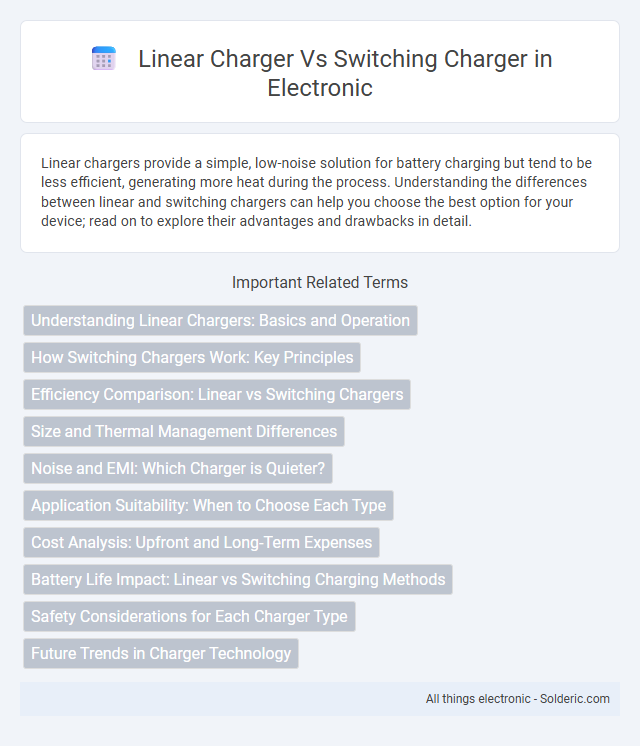Linear chargers provide a simple, low-noise solution for battery charging but tend to be less efficient, generating more heat during the process. Understanding the differences between linear and switching chargers can help you choose the best option for your device; read on to explore their advantages and drawbacks in detail.
Comparison Table
| Feature | Linear Charger | Switching Charger |
|---|---|---|
| Efficiency | Low (40-60%) | High (80-95%) |
| Heat Generation | High due to voltage drop | Low with efficient power conversion |
| Size | Small, simple circuitry | Larger, complex components |
| Cost | Lower initial cost | Higher initial cost |
| Noise | Silent operation | Can generate electrical noise |
| Application | Low power devices, simple designs | High power devices, fast charging |
| Voltage Regulation | Linear, less precise | Switching, highly precise |
Understanding Linear Chargers: Basics and Operation
Linear chargers regulate voltage by dissipating excess power as heat through a series pass transistor, offering simplicity and low noise ideal for small devices. These chargers maintain a constant voltage output by adjusting current flow, resulting in efficient charging for batteries with predictable voltage needs. Their straightforward design ensures minimal electromagnetic interference, making them suitable for noise-sensitive applications.
How Switching Chargers Work: Key Principles
Switching chargers regulate voltage by rapidly turning on and off a transistor, allowing energy to be stored temporarily in inductors or capacitors, which improves efficiency and reduces heat compared to linear chargers. Their key principles include pulse-width modulation (PWM) to control output voltage precisely and the ability to step voltage up or down as needed. You benefit from faster charging times and better energy conservation with switching chargers, especially in devices requiring high power and efficiency.
Efficiency Comparison: Linear vs Switching Chargers
Switching chargers offer significantly higher efficiency, often exceeding 85-90%, by regulating voltage through high-frequency switching, minimizing energy loss as heat. In contrast, linear chargers operate by dissipating excess voltage as heat, resulting in lower efficiencies typically around 50-60%. The superior efficiency of switching chargers enhances battery charging speed and reduces energy consumption, making them preferable for power-sensitive applications.
Size and Thermal Management Differences
Linear chargers feature simpler circuitry, resulting in a more compact size but generate significant heat due to voltage regulation through resistance, which requires effective thermal management such as heat sinks. Switching chargers, although typically larger because of inductors and additional components, offer superior thermal efficiency by converting voltage through high-frequency switching, minimizing heat dissipation. This thermal advantage allows switching chargers to maintain lower operating temperatures and improve reliability in space-constrained or high-power applications.
Noise and EMI: Which Charger is Quieter?
Linear chargers produce significantly less electrical noise and electromagnetic interference (EMI) compared to switching chargers due to their simple design and steady voltage regulation. Switching chargers generate higher EMI because of high-frequency switching components, which can cause audible noise and interference in sensitive electronic circuits. For applications where quiet operation and minimal EMI are critical, linear chargers are the preferred choice.
Application Suitability: When to Choose Each Type
Linear chargers are ideal for applications requiring low noise and simplicity, such as small portable devices or sensitive audio equipment, due to their efficient voltage regulation and minimal electromagnetic interference. Switching chargers suit devices demanding higher efficiency and faster charging times, especially in power-intensive applications like smartphones and laptops, where heat dissipation and energy savings are critical. Your choice depends on the specific application needs, balancing factors like power efficiency, thermal management, size, and noise sensitivity.
Cost Analysis: Upfront and Long-Term Expenses
Linear chargers typically have a lower upfront cost due to their simpler design, but they can lead to higher long-term expenses because of inefficient power conversion and increased heat dissipation, which may reduce battery lifespan. Switching chargers, while more expensive initially due to complex circuitry, offer better energy efficiency and cooler operation, resulting in lower electricity bills and extended battery health over time. Your choice should balance immediate budget constraints with potential savings from improved performance and durability.
Battery Life Impact: Linear vs Switching Charging Methods
Linear chargers regulate voltage by dissipating excess power as heat, resulting in slower charging and less stress on battery components, which tends to extend battery lifespan. Switching chargers use high-frequency switching to efficiently convert voltage, leading to faster charging times but increased electrical noise and heat, which can contribute to accelerated battery degradation. Optimal battery life depends on balancing charging speed with thermal management and minimizing electrical stress inherent in switching methods.
Safety Considerations for Each Charger Type
Linear chargers offer inherent safety advantages due to their simple design and low electromagnetic interference, reducing the risk of overheating and electrical noise in sensitive devices. Switching chargers, while more efficient and faster, require advanced circuitry and protective components to manage voltage spikes and prevent potential hazards such as short circuits or thermal runaway. Proper safety features like thermal protection, current limiting, and quality components are critical in both charger types to ensure reliable and safe battery charging.
Future Trends in Charger Technology
Future trends in charger technology emphasize increased efficiency and faster charging speeds, with switching chargers leading the advancement due to their superior energy conversion rates and reduced heat generation. Linear chargers, while simpler and quieter, are gradually becoming less prevalent in favor of compact, smart switching chargers featuring adaptive voltage regulation and integration with IoT devices. Emerging developments highlight wireless switching chargers powered by GaN (Gallium Nitride) semiconductors, promising smaller form factors and enhanced power density for next-generation electric vehicles and portable electronics.
linear charger vs switching charger Infographic

 solderic.com
solderic.com